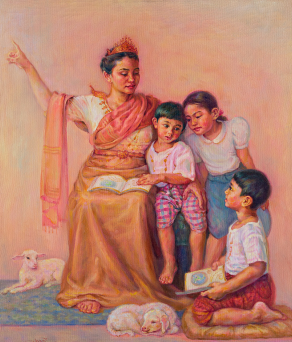Articles/Essays – Volume 55, No. 1
In Praise of Belly Buttons (four meditations)
Podcast version of this piece.
[one]
My belly is expanding.
It is not as much as I had expected—nothing like the maternity models (who I suspect might not even be pregnant) who now populate my computer screen’s pop-up ads.
Nonetheless, it expands, inch by inch, week by week, straining veins and skin, with my belly button starting to tighten and protrude outward.
“Belly button” is such a funny term. I suppose “navel” is more sophisticated, with all its connotations of centering, of the middle, with its cognates in French and German.
But I prefer “belly button.” For a navel is still a navel, and even if “navel orange” sounds more marketable than “belly button orange,” the knob at the top still reminds you of an umbilicus, not because oranges are the center of the marketplace, let alone the world, but simply because it looks like a belly button.
I suppose I love the term “belly button” because it’s such an apt description. It does look something like a button, albeit one more oval than circular, with rays protruding from its hollowed center, a mundane cavity (or, for some of us, a knob) in the middle of our abdomens; a physical reminder of the nine-month lifeline between mothers and children; a remnant of the womb that incubated us, giving oxygen, blood, and energy.
And every day, my belly button tightens, stretching with my stomach, its eloquent silence a sermon on the miracle of life, the mystery of love.
[two]
Toddlers are fairly obsessed with their belly buttons. They are such abnormal, oblong things, after all. It is not uncommon to see a gaggle of three-year-olds congregated, giggling and pulling their shirts above their midriffs, poking and jabbing at their own and others’ belly buttons. Belly buttons are funny, belly buttons are fascinating. Why hide them when you can show them off?
Unafraid of their bodies, they gleefully, proudly point to their female sign, a key to a home unremembered.
[three]
I look for signs of Her presence in the grand and the mundane, from constellations to belly buttons. I search for Her like the hatchling bird in P. D. Eastman’s Are You My Mother? (As a three-year-old, I adored this book and memorized it before I could officially read, turning the pages as I “read” to my younger sister: “I will find her, I will!” and, “You are not my mother. You are a SNORT!”)
Heavenly Mother certainly is not an exhaust-exhuming excavator like the one the little bird mistook for his mother. She is, I believe, more likely to be found in kittens or hens or hatchlings than in modern machinery. But even then, I search all the same, believing that Her divine patterns can be found anywhere, on anything, on anybody, including (and perhaps especially) myself.
I wonder if there is a distinct mark on my spirit, like the dent left by the umbilical cord, somewhere in my mind, in my soul, in my body. If I delve far enough inside myself, will I uncover the hidden mysteries of Her spiritual mitochondrial DNA?
Or maybe that spiritual umbilical cord has never left. Unlike the worried mama bird of Are You My Mother?, She has not left go find food, for She is life, She is nourishment, She is energy.
[four]
In the temple, I wait, hoping to one day part the veil and see Her face. I imagine Her, standing at the veil, waiting for me—waiting for us—to find Her, to see Her signs in the seasons, in children, in Her Son, in ourselves, and to point out those signs joyfully, unashamed of Her, unashamed of the mystery and miracle of Her love.
Note: The Dialogue Foundation provides the web format of this article as a courtesy. There may be unintentional differences from the printed version. For citational and bibliographical purposes, please use the printed version or the PDFs provided online and on JSTOR.


 Back to full Issue
Back to full Issue

